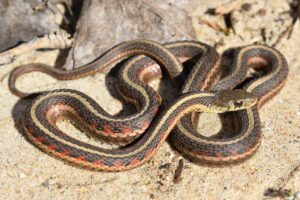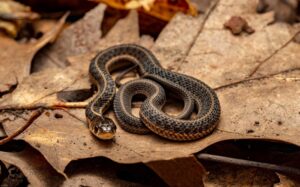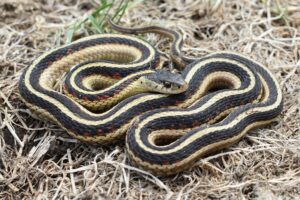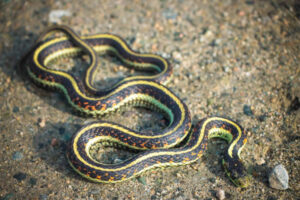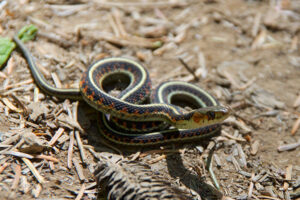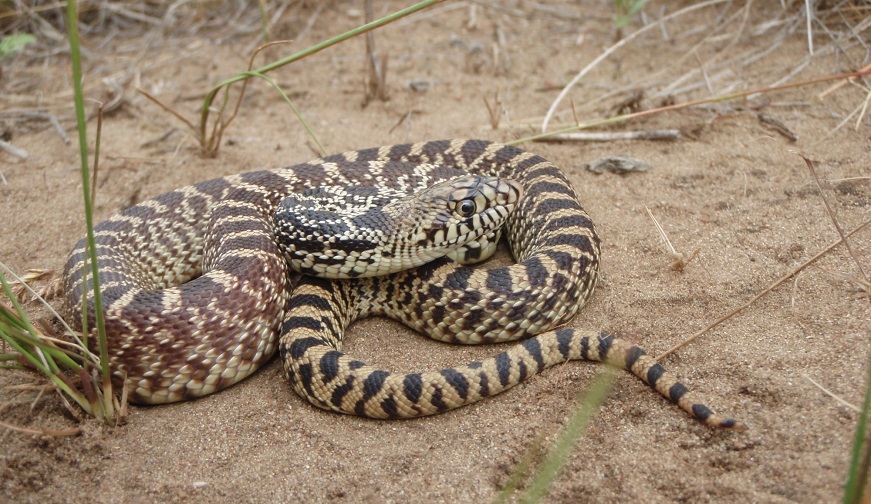The common garter snake is a diurnal, thin colubrid. It is endemic to North America and can be found throughout the continent. It is the state reptile of Massachusetts.
In summer, it is most active in the late afternoon and morning. In the cooler months, it stays active only in the warm afternoons. It is active the entire year in warmer southern areas, but in other places, it goes into brumation in the winter. That doesn’t stop it from emerging to bask in the sun on warm winter afternoons, though.
Scientific Classifications
- Suborder:Serpentes
- Family:Colubridae
- Genus:Thamnophis
- Species:T. sirtalis
Conservation Status
Subspecies
This snake has thirteen recognized subspecies.
- Eastern garter snake (Thamnophis sirtalis sirtalis)
- Red-sided garter snake (Thamnophis sirtalis parietalis)
- California red-sided garter snake (Thamnophis sirtalis infernalis)
- Red-spotted garter snake (Thamnophis sirtalis concinnus)
- New Mexico garter snake (Thamnophis sirtalis dorsalis)
- Puget Sound garter snake (Thamnophis sirtalis pickeringii)
- San Francisco garter snake (Thamnophis sirtalis tetrataenia)
- Chicago garter snake(Thamnophis sirtalis semifasciatus)
- Maritime garter snake(Thamnophis sirtalis pallidulus)
- Texas garter snake (Thamnophis sirtalis annectens)
- Valley garter snake (Thamnophis sirtalis fitchi)
- Blue-striped garter snake (Thamnophis sirtalis similis)
- Thamnophis sirtalis lowei
Description
Size
The average total length of the common garter snake, including the tail, is 22 in (55 cm), with the maximum recorded length being 54 in (137 cm). Few of them grow more than 4 ft (1.2 m), with most of them remaining smaller. The average body mass is 5.3 oz (150 g).
Color and Appearance
They have longitudinal stripes in various colors, including blue, green, gold, yellow, orange, red, black, and brown. But most of them have a pattern of yellow stripes against a brown, black, or green background.
Are They Dangerous to Humans
The mildly venomous, shy garter snake is not dangerous to humans. Its venom is only toxic to its prey. The bite can only cause slight burning, itching, and swelling in humans. Handling or harming it can make it secrete a foul-smelling musk from its post-anal glands. It is resistant to natural poisons like that of the rough-skinned newt (that can kill a human if ingested) and American toad. It can absorb the toxins in its body, rendering itself poisonous, thus deterring potential predators.
The warmer the temperature of the snake, the more likely it is to run away from a predator. A snake having a cooler body temperature is more likely to remain stationary or attack. Males are more inclined to flee. Common garter snakes with more aggressive defensive behavior tend to have high stamina and are very fast in their movements.
The captive-bred common garter snakes have gentle dispositions and don’t mind handling.
Common Garter Snakes at a Glance
Distribution
The common garter snake can be found as far south as the southernmost tip of Florida in the US and as far north as the southernmost tip of the Northwest Territories of Canada. It inhabits altitudes ranging from sea level to the mountains.
Habitat
It lives in fields, forests, streams, prairies, meadows, wetlands, ponds, and marshes. It is often found near water.
Lifespan
The average lifespan of the colubrid is 4 years, but it can live for up to 10 years in the wild.
Predators
Large fish like catfish and bass, common snapping turtles, American bullfrogs, raccoons, hawks, wild turkeys, foxes, bigger snakes, domestic dogs, and cats prey on the common garter snake.
Diet
It mainly eats earthworms and amphibians but will also take slugs, leeches, insects, crayfish, snails, lizards, fish, rodents, small birds, and other snakes. It is skilled in catching fast-moving animals like tadpoles and fish.
Reproduction
Ovoviviparous (gives birth to live young from eggs that hatch inside the body)
The population of males is much greater than that of females. Hence, the species forms ‘mating balls’ in the breeding season, with 1-2 females fully surrounded by 10 or more males. Sometimes, when a male mates with a female before hibernation, she stores the sperms internally till spring when she allows her eggs to be fertilized. If she again mates in spring, the fall sperms degenerate, and the spring sperms fertilize her eggs. The female gives birth to 12-40 live babies from July to October.
In the early part of the mating ritual, when the snakes are emerging from hibernation, the males generally come out first to prepare themselves for copulating with the females when they wake up. Some males assume a deceptive behavior by posing as females. They lure the other males away from the den with a fake pheromone.
After driving the competitors away, the deceptive male starts behaving normally and races back to the burrow to capture a female as soon as she emerges. He becomes the first to mate with as many females as possible. This method also helps raise his body temperature as he tricks other males into surrounding him. It is particularly helpful for specimens living in colder climates. The males exhibiting this type of mimicry are typically found to mate more often with females than the males that do not do so.
Similar Species
Butler’s Garter Snake
The lateral stripes in the common garter snake fall on the 2nd and 3rd scale rows. On the other hand, these stripes fall on the 3rd and 4th scale rows in the Butler’s garter snake (Thamnophis butleri). Plus, the common garter snake is larger, with a more pronounced head and neck distinction.
Western Ribbon Snake
The western ribbon snake (Thamnophis proximus) is usually more slender with the lateral stripes found on scale rows 3 and 4, while it is scale rows 2 and 3 for the common garter snake. Additionally, the labial scales of the former are unpatterned, while those of the latter have dark marks along the edges.
Eastern Garter Snake
The eastern garter snake (Thamnophis sirtalis sirtalis) has a darker body with lighter yellow stripes. On the other hand, the common garter snake generally has darker stripes on a lighter background color.
Care Sheet
Size of the Enclosure: The babies can be kept in 5-gallon tanks. The adults need 15-gallon ones. The breeding pairs should be housed in 25-gallon tanks or bigger.
Temperature: The cooler end of the cage should be maintained at 75°F and the warmer end at 85°F. The temperature of the basking area should be 95°F.
Humidity: The suitable humidity level of the terrarium is 40-60%. It should be slightly higher when the pet is shedding.
Substrate: A deep substrate like sphagnum moss, coconut fiber bedding, and reptile bark are good options as they allow the snake to burrow. Shredded paper goods like newspapers, paper towels, and readily available recycled paper products can also be used.
Feeding: The juveniles can be fed a combination of minnows, feeder guppies, fish fillet pieces, and earthworms every alternate day. The adults can be given small rodents like pinkies or mice once a week.
Source
sdherps.org, ongkongsnakeid.com, .istockphoto.com, wildherps.com

